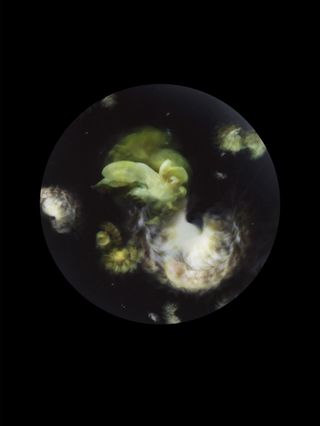The Art of Micronesia Is the Best Known and Best Understood of Oceanic Art
Mysterious 'Plastic Plankton' Art Exhibit Reveals Extent of Ocean Pollution

A series of eerie, stunning images reveals the extent of plastic polluting the earth's oceans — past transforming the trash bits into images that wait like teensy, ethereal ocean creatures.
In the images, created by creative person Mandy Barker, bits of ocean flotsam — such as stroller wheels, toy horses, burnt plastic flowers and six-pack rings — accept been transformed into plankton-like bounding main creatures. Barker'south art exhibit will soon be published in the book "Beyond Drifting: Imperfectly Known Animals" (Overlapse, forthcoming May 2017). [Run across Barker's Mysterious Plastic Plankton Ocean Creatures]
Plastic oceans
Barker originally came up with the idea for the project at a scientific conference in Berlin. She met a researcher from Cobh, Ireland, who told her the long-lost story of marine biologist John Vaughan Thompson, who had made many of his observations in the same region.
"He fabricated these pioneering discoveries virtually plankton," withal his history and life has remained mostly obscure, Barker told Alive Science.
At the aforementioned conference, she'd heard a talk about plankton that had begun to ingest plastic drifting in the ocean. (A huge swath of the Pacific Ocean ― an surface area the size of Texas ― is filled with plastic, and within this region plastic islands take even begun forming. Other research has shown that the oceans are filled with 250,000 tons of trash.)
She decided to recreate the observations of Thompson, simply focus on the newer "inhabitants" of the ocean.
"My thought was to revisit the areas where he'd collected plankton, but I'd collect plastic," Barker said. "He was collecting natural objects, and at present in place of the natural objects are the man-made debris."
Fantastic creatures
Then, Barker returned to Cobh and gathered debris from the seashore, then advisedly composed photographs to make the plastic specimens expect like slides of plankton from the 1800s. The resulting images resemble slides of fantastical microscopic plankton.
The photographs were "done in dim light, which enables them to move and make these sort of creations, well-nigh sort of pond as if they're plankton in the ocean."
She also created a chiffonier total of specimens and a naturalist's notebook from the time meant to represent Thompson's inquiry memoirs published in 1830s, chosen "Imperfectly Known Animals."
The series of work "Across Globe-trotting: Imperfectly Known Animals" volition be on exhibit at the FORMAT Photography Festival from March 24 to April 23, and at the Prix Pictet Award at The Victoria & Albert Museum, London, award anniversary on May 4 (with public viewing available from May 5 through May 28), and at the Sirius Arts Middle, in Cobh, May 27 to July two.
Barker's other work has likewise focused on plastic droppings, including a series chosen "WHERE…accept I been," which shows the plastic debris from balloons that burst loftier in the Earth'south atmosphere, before settling downwards to World, causing problems for marine life. Some other of her series is called "Soup," which shows the soup of plastic droppings suspended in the Great Pacific Garbage Patch in kaleidoscopic images.
Originally published on Live Science.
giordanodeshe1991.blogspot.com
Source: https://www.livescience.com/58311-mandy-barker-plastic-plankton-exhibit.html

0 Response to "The Art of Micronesia Is the Best Known and Best Understood of Oceanic Art"
Post a Comment